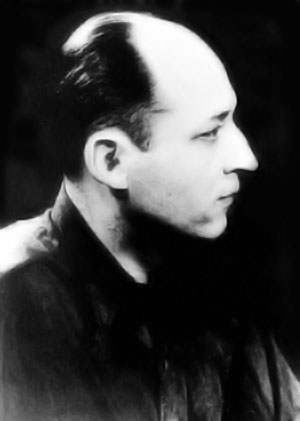Benjamin Péret facts for kids
Quick facts for kids
Benjamin Péret
|
|
|---|---|
 |
|
| Born | 4 July 1899 Rezé, Loire-Atlantique, France
|
| Died | 18 September 1959 (aged 60) Paris, Île-de-France, France
|
| Nationality | French |
| Known for | Writing |
| Movement | Dada, Surrealism |
Benjamin Péret was a French poet. He was born on July 4, 1899, and passed away on September 18, 1959. He was an important part of the Dada and Surrealist art movements in France. He loved using something called "Surrealist automatism" in his writing. This was a way to create art or writing without thinking too much, letting ideas flow freely.
Contents
Benjamin Péret's Life Story
Benjamin Péret was born in Rezé, France, on July 4, 1899. When he was a child, he didn't like school very much. Because of this, he didn't get a lot of formal education. In 1912, he went to a Local Art School. However, he left in 1913 because he wasn't very interested in studying there. After that, he spent a short time at a School of Industrial Design.
Joining the Army
During World War I, Péret joined the French army. He became a soldier in the Cuirassiers, a type of cavalry unit. He did this to avoid getting into trouble for painting on a local statue. He fought in the Balkans and was later sent to Salonica, Greece.
While traveling by train with his unit, he found a magazine called Sic. It had poems by Apollinaire inside. This discovery made him fall in love with poetry. Near the end of the war, he got sick in Greece. This led to him being sent back to France. He spent the rest of the war in Lorraine.
Becoming a Poet
After the war, Benjamin Péret joined the Dada movement. This was an art movement that questioned traditional art and ideas. Soon after, in 1921, he published his first book of poems. It was called Le Passager du transtlantique.
Later, he left the Dada movement. He decided to follow André Breton and the new Surrealist movement. Surrealism was another art movement that explored dreams and the unconscious mind. Péret worked closely with other Surrealists. He also influenced the famous Mexican writer Octavio Paz.
Working on Journals and Traveling
In 1924, Péret helped edit a journal called La Révolution surréaliste. This journal was very important for the Surrealist movement. He became the main editor in 1925. In 1928, he published another book, Le Grand Jeu.
In 1929, he moved to Brazil with his wife, Elsie Houston. Two years later, in 1931, his son Geyser was born in Rio de Janeiro. A few months after his son's birth, Péret was arrested. He was asked to leave Brazil. This happened because he was seen as a "Communist Agitator." He had helped start the Brazilian Communist League. This group followed the ideas of Trotsky, a political thinker.
Later Years and Travels
After returning to France, Péret went to Spain. This was when the Spanish Civil War began. He joined a group of fighters called an anarchist militia. He fought at Pino de Ebro.
Back in France in 1940, he was put in prison for his political actions. After he was released, he sailed to Mexico. The American-based Emergency Rescue Committee helped him travel. He wanted to study old myths from before Columbus came to America. He also studied American folklore. Péret had hoped to move to the United States. However, he couldn't because of his connections to communist groups. He went to Mexico with his partner, the Spanish artist Remedios Varo.
In Mexico City, he met other European thinkers and artists. He was especially inspired by Wolfgang Paalen, an Austrian painter. Paalen had a large collection of "Totem Art" from the Northwest Coast of British Columbia. In 1943, Péret finished a long essay about why poetic myths are important. He used the myths and art of the Northwest Coast as examples. This essay was published in New York in a magazine called VVV. While living in Mexico City, Péret also met Natalia Sedova, who was Trotsky's widow.
He stayed in Mexico until the end of 1947. Then, he returned to Paris. Benjamin Péret passed away there on September 18, 1959.
See also
 In Spanish: Benjamin Péret para niños
In Spanish: Benjamin Péret para niños

